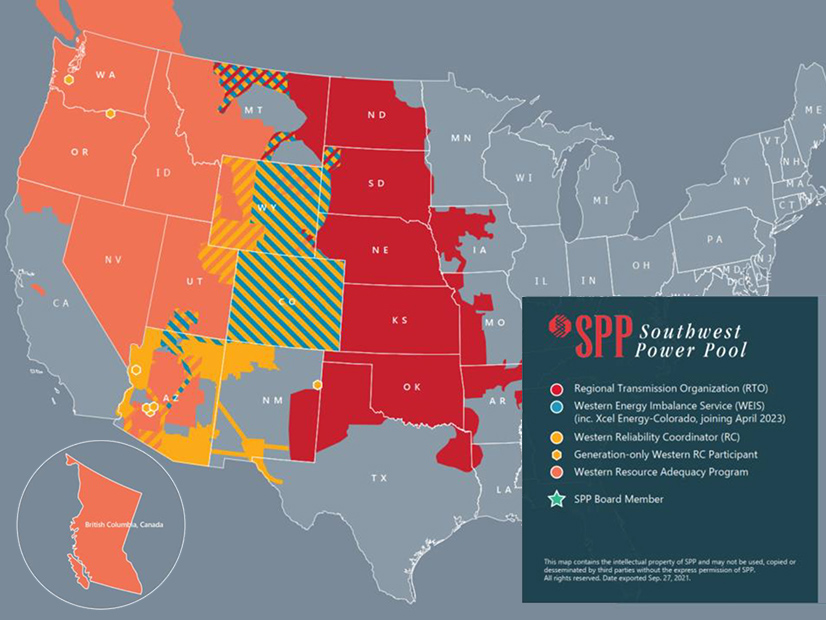The close of 2022 finds PJM in a state of flux, with recent FERC orders and pending dockets carrying significant changes to the RTO’s expanding interconnection queue and the structure of its capacity markets, as well as ongoing stakeholder discussions on how to account for the capacity from intermittent resources. Many of those discussions that have culminated in solutions will begin their implementation in the new year, while others still in deliberations aim to wrap up in the first few months of 2023.
Here’s a review of some of the major stories of 2022 and ongoing discussions continuing into 2023.
Finalization of Capacity Auction Pushed into 2023
The first order of business in 2023 will be a review of the “indicative” 2024/25 capacity auction results on Tuesday, following a concern that the DPL South locational deliverability area (LDA), which is centered around the Delmarva Peninsula, could experience artificially inflated prices. (See Capacity Auction ‘Mismatch’ Roils PJM Stakeholders.)
During the Dec. 21 Members Committee meeting, Senior Vice President of Market Services Stu Bresler said the design of the reliability requirement for each LDA can create a situation where large facilities or intermittent generators cause the requirement to increase as more resources are brought online because of the need to account for when those resources are offline. When those resources are included in the resource modeling and lead to an elevated reliability requirement, but do not ultimately enter into the auction, it can create the appearance of a shortage that doesn’t exist.
PJM submitted concurrent Federal Power Act Section 205 and 206 filings with FERC on Dec. 23 seeking that the auction results in DPL South be found unjust and unreasonable and to allow the RTO to adjust the reliability requirement for the LDA “based on the actual supply of resources that submitted offers into the auction” (ER23-729, EL23-19).
The Section 206 filing argues that this would effectively function as an additional factor in the evaluation of offers into the market before the results are finalized.
“Absent the ability to include this additional factor in the optimization algorithm, PJM would be forced to utilize a materially inaccurate locational deliverability area reliability requirement that does not reflect the actual capacity needs of the particular LDA in question and would result in an unjust and unreasonable outcome,” the RTO said.
Several stakeholders raised concerns that the move would establish a precedent of market changes being implemented in the middle of auctions. Those reservations extended to PJM’s determination to publish the DPL South results Tuesday, which could hamstring the commission’s ability to allow market participants to alter their offers to reflect any rule changes.
Bresler said it is not a step being taken lightly, but the scale of the impact to DPL South warrants immediate measures while concrete long-term solutions are sought. In the filings before FERC, PJM said the clearing price for the LDA would be more than four times higher if the proposed changes are not made.
“More particularly, based on preliminary auction data, PJM estimates that as a result of this confluence of events in this small LDA, should PJM complete the auction and award capacity commitments, the clearing price for the DPL-S LDA (and the revenues received by capacity market sellers in this small LDA) would be more than four times what the clearing price should be if the planned generation capacity resources that did not offer in the auction are excluded from the locational deliverability area reliability requirement given that they did not offer into the BRA,” PJM told FERC.
The opening of the auction had already been delayed from August to November as part of a FERC-approved adjustment to the capacity auction timeline through the end of 2023 to allow PJM additional time to implement a revised forward-looking energy and ancillary services (E&AS) offset. The commission reversed its approval of the RTO’s forward-looking E&AS offset in December 2021 and granted the delayed timeline on Feb. 23, pushing the January 2022 auction to June. (See FERC Approves PJM Capacity Auction Date Changes.)
The 2023 auctions were postponed from February to June and from August to November. The schedule is set to return to normal with the 2027/28 BRA, in May 2024.
Capacity Prices Fall for 2023/24
The 2023/24 capacity auction, held in June, saw prices fall by nearly one-half relative to the previous auction, with 144,871 MW of capacity sold for $2.2 billion for the delivery year starting in June 2023. The 2022/23 delivery year saw a total capacity bill of around $4 billion. (See PJM Capacity Prices Crater.)
Several market changes likely impacted prices, including a decreased unit-specific market seller offer cap (MSOC), the use of a historical E&AS revenue offset, the introduction of the effective load-carrying capability (ELCC) methodology for measuring intermittent resource capacity and the near elimination of the minimum offer price rule.
The Independent Market Monitor found that the auction results were competitive, largely because of the new MSOC. (See Monitor Finds PJM’s 2023/24 Base Residual Auction Competitive.)
Accreditation of Intermittent Resources Remains Divisive
Stakeholders are also pushing forward with an effort to have a new accreditation methodology for ELCC resources in place for the 2025/26 BRA in June. (See PJM Stakeholders Review Proposals on CIRs for ELCC Resources.)
The often contentious issue has been discussed in more than 25 meetings since a problem statement was adopted in early 2021, a referral to the FERC Enforcement hotline and a complaint to the commission filed by economist Roy Shanker on Nov. 30. At issue is whether PJM has been in violation of its tariff by improperly permitting energy above renewable resources’ capacity interconnection rights (CIRs) to be entered into the Reliability Pricing Model (RPM) auctions as capacity.
In his complaint, Shanker alleged that the practice results in diminished reliability; load overpaying for “phantom capacity” that does not meet reliability standards; artificial reduction of capacity prices for other resources; and inefficient economic decisions from market participants acting on potentially inaccurate information. Because the resources already have established interconnection service agreements (ISAs) and defined CIRs, the complaint states that an immediate solution can be implemented by capping capacity offers at the rates determined in those agreements with each resource (EL23-13).
The commission approved a PJM request for an extension from Dec. 20 to Jan. 10 to provide more time for its response to the complaint.
At the start of the year, the PJM Power Providers (P3) sent a letter to the PJM Board of Managers arguing that by allowing resources to acquire capacity obligations greater than their demonstrated deliverability, the RTO has “materially destabilized the market” and is not upholding its tariff. The board responded with a letter to stakeholders saying that it believes the accreditation of intermittent resources has been appropriate and compliant with the tariff.
The stakeholder discussions on a long-term solution has resulted in 11 packages of changes being offered as potential solutions, of which six remain under consideration by the Planning Committee. Though they agree on the ultimate methodology for accrediting intermittent resources, the packages vary widely on where to cap capacity offers for resources that already hold an ISA. The transitionary measures range from granting ELCC resources higher CIRs and having load pay for the transmission upgrades to capping their current CIR rating and requiring the resource to re-enter the interconnection queue to request a higher accreditation.
The PC is set to consider endorsement of a package on Jan. 10, while the Markets and Reliability Committee and MC are set to vote on Jan. 25. The proposals would also require approval from the board, which is set to take up the issue on Feb. 1. The solutions all look to be implemented for the 2025/26 BRA, but they differ in whether that is a target or mandatory.
Interconnection Queue Overhaul Approved
Following years of a growing backlog in its interconnection queue, FERC on Nov. 29 approved a proposal from PJM to overhaul how the RTO studies network upgrades for new projects. According to PJM, the number of new service requests it received tripled from 2019 through 2022 to more than 2,700 projects pending in the queue as of May 10 (ER22-2110).
The new system aims to reduce completion times by clustering projects together both for studying the upgrades required and allocating costs, as well as by discouraging speculative project submissions by requiring evidence of site control and progressively scaling readiness deposits throughout the process. (See FERC Approves PJM Plan to Speed Interconnection Queue.)
Once again the transitionary provisions were the source of much of the debate around the changes. Under the new system, projects submitted between April 2018 and September 2021 with a price tag above $5 million will be studied under two sequential transitionary cycles, while less expensive projects will be placed in an expedited “fast-track” queue.
Concerns raised by protesters questioned whether the measures would be enough to weed out proposals seeking to offload the work of testing a project’s viability onto PJM staff and whether site control requirements could allow viable projects to be forced out of the queue.
During the Organization of PJM States Inc.’s (OPSI) annual meeting on Oct. 18, PJM Vice President of Planning Kenneth Seiler said many of the smaller projects already in the interconnection queue could have their studies complete within six months and that the fast-track could be completed within two years after its approval.
Division over Design of Capacity Market
As FERC continues to weigh whether to approve PJM’s proposed changes to the RPM, generation owners are seizing upon comments made by PJM CEO Manu Asthana — in which he expressed concern about the pace of new generator installations — to argue that the capacity market should be structured to procure additional capacity. (See PJM MRC Briefs: Oct. 24, 2022.)
At the RTO’s annual meeting on Oct. 24, Asthana said about 40 MW of generation is expected to retire by 2030 as construction of new resources lags behind expectations and load continues to grow.
“We have time, but we don’t have time to waste,” he said. “We need to take action to ensure we retain an adequate supply of dispatchable generation through the [clean energy] transition.”
Protests against PJM’s proposed variable resource requirement (VRR) demand curve have pointed to Asthana’s statement as evidence that the RPM should be designed to incentivize the retention and development of all types of capacity (ER22-2984).
The Quadrennial Review filing proposed changing the reference resource to a combined cycle generator, revising the calculation of the gross cost of new entry (CONE) and changing how it is adjusted in years between reviews, steepening the VRR curve and shifting from a historical E&AS offset calculation to a forward-looking offset.
P3 protested that the changes are not transparent and would disincentivize the sort of generation Asthana said is needed over the coming decade. (See PJM Defends Quadrennial Review Parameters from Generator Protests.)
“To P3, this sounds like PJM is indeed on the cusp of a reliability crisis and the impact of the instant filing will coincide directly with the predicted reliability challenges in PJM,” the group said.
In response to previous P3 protests, several environmental and public advocacy groups — jointly filing as the Public Interest Entities — said the claims are unfounded and noted that PJM remains well above its “conservative” reliability standards.
“Rather than a market ‘on life support,’ PJM’s capacity market remains robust, procuring — indeed over-procuring — the resources necessary to maintain reliability,” they said.






